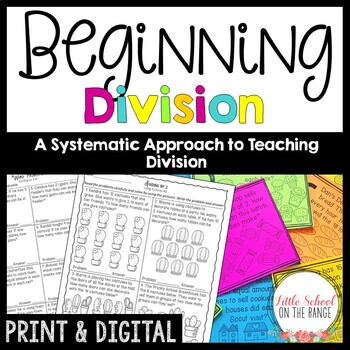Beginning Division | Print and Digital
- PDF
- Google Apps™

What educators are saying
Also included in
- Looking for a great way to introduce multiplication and division? This bundle is ideal for use distance learning as it allows students to work independently and also has a link for Google Classroom. NOTE: This resource now has Google Classroom activities, making it ideal for digital distance learniPrice $10.00Original Price $12.00Save $2.00
Description
Looking for a hands-on way to ease your students into division? This unit is perfect introduction to division! It begins with allowing students to draw pictures and then move on to word problems. Practice is given for dividing by 2,3,4, and 5. This can be used in the regular education classroom or special education classroom. It can be used for extra practice, RTI, or differentiated instruction. This is ideal for distance learning as it allows students to work independently.
This resource has Google Classroom activities, making it ideal for using in the classroom or online! Please see the 2nd page of the PDF for the link!
This unit includes:
Using Counters to Divide by 2
Dividing by 2 Using Pictures – 2 Pages
Word Problems for Dividing by 2 – 2 Pages
Using Counters to Divide by 3
Dividing by 3 Using Pictures – 2 Pages
Word Problems for Dividing by 3 – 2 Pages
Using Counters to Divide by 4
Dividing by 4 Using Pictures – 2 Pages
Word Problems for Dividing by 4 – 2 Pages
Using Counters to Divide by 5
Dividing by 5 Using Pictures – 2 Pages
Word Problems for Dividing by 5 – 2 Pages
Using Counters to Divide by 2,3,4, & 5
Dividing by 2,3,4,& 5 Using Pictures – 2 Pages
Word Problems for Dividing by 2,3,4,& 5 – 2 Pages
Word Problems Assessment – 2 Pages
Set of 24 Task Cards with Answer Sheet
Suggestions for Using this Unit
Answer Key
What have satisfied customers said about this product?
“Great Resource! Does a great job reviewing skills students need practice on. This made my life so much easier. Kids were struggling with multiplication and I was dreading doing division. But with these it made it simple. They were very confident in solving the word problems. Thanks so much!”
“This was perfect for my class and really helped them understand division!”
“What a great resource to help introduce division!”
“Love how this resource gives them the visuals to start! Great way to start division!!”
Not sure if this is for you? Download the PREVIEW for a free sample!
Check out the Beginning Multiplication Unit at:
Beginning Multiplication No Prep Unit – Multiplying By 2,3,4, and 5
Or, buy the BUNDLE and SAVE!!!






